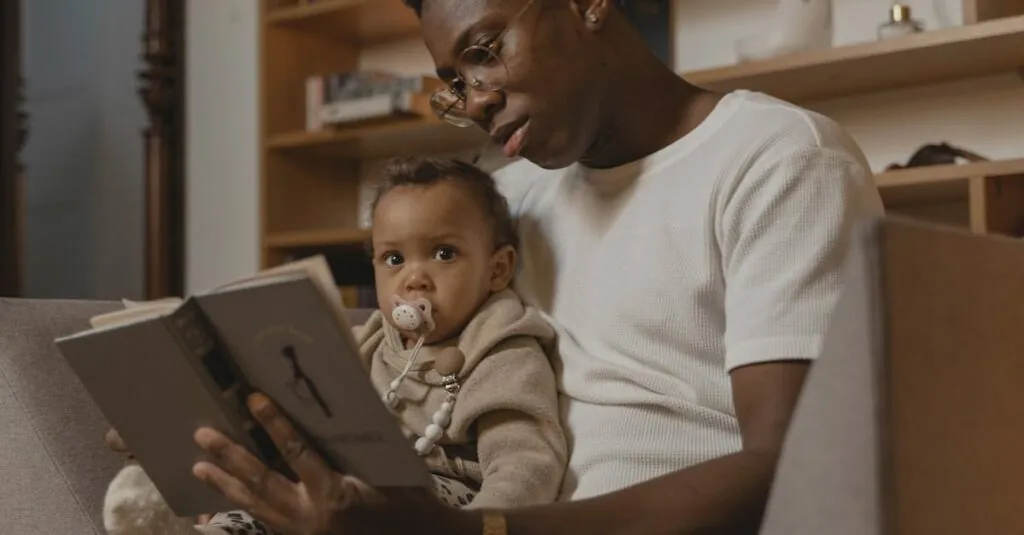Divorce can feel like stepping into a minefield, especially when kids are involved. Parents often wonder how to break the news without causing a meltdown—or worse, turning into the villain of the story. But don’t panic; it’s possible to navigate this tricky conversation with a bit of humor and a whole lot of love.
Imagine sitting down with your kids, armed with honesty and a sprinkle of lightheartedness. It’s not about sugarcoating the situation but about framing it in a way that they can understand. With the right approach, you can help them see that while things are changing, their world can still be filled with stability and support. Let’s dive into some effective strategies to make this difficult talk a little easier—and maybe even a bit funny.
Table of Contents
ToggleUnderstanding the Impact of Divorce on Children
Divorce significantly affects children and influences their emotions and coping mechanisms. Parents must recognize these impacts to support their kids effectively during this transition.
Emotional Reactions to Divorce
Children often experience a range of emotional reactions when parents divorce. Confusion frequently arises as they struggle to understand what the divorce means for their family. Sadness may also manifest as they face the potential loss of their family structure. Fear commonly surfaces, especially concerning what living arrangements will be like. Anger can emerge, sometimes directed at one or both parents for the situation. Each child’s emotional response varies, necessitating patience and understanding from parents throughout the process.
Age-Appropriate Responses
Age plays a crucial role in how children process and respond to divorce. Young children may not grasp the full implications, so simple explanations suffice for their understanding. In contrast, tweens often seek more detailed information, expressing feelings through conversation or artwork. Teenagers typically handle complex emotions, needing open dialogue to convey their thoughts. Various developmental stages require tailored approaches, ensuring that each child feels heard and supported in their unique way.
Preparing for the Conversation
Preparing for the conversation about divorce involves careful consideration. Selecting the right moment and environment plays a crucial role in ensuring that children feel safe and secure during this discussion.
Timing and Setting
Choose a calm time without distractions to broach the subject. Mornings can feel rushed, so afternoons or evenings often provide more peace. Ensuring both parents can participate demonstrates unity, even amid change. Safe spaces, such as a favorite room or during a quiet family meal, foster a comforting atmosphere. A familiar setting can help children express their feelings more openly.
Gathering Your Thoughts
Gather essential points to convey before the conversation begins. Outline key messages to share without overwhelming the child. Focus on sharing that both parents love the child and that divorce isn’t the child’s fault. Anticipate questions regarding living arrangements, school, and communication, as they often arise. Prepare answers to common inquiries to assure children of their importance in the process. Practicing with a partner or trusted friend can clarify thoughts and enhance delivery.
How to Tell Your Kids About Divorce
Communicating about divorce to children requires sensitivity and understanding. Focus on delivering the message clearly to help them process this significant change.
Using Clear and Simple Language
Parents should aim for language that is straightforward and easily understood. Avoid complex terms that can confuse children. When discussing divorce, use direct statements that convey love and support. For example, saying “Both parents love you” reinforces parental affection. Young children often benefit from simple explanations, while tweens and teens may require a bit more detail. Always ensure the tone remains calm and gentle, creating an atmosphere of safety. Clarity helps alleviate fears, making it easier for them to comprehend the situation.
Addressing Their Questions and Concerns
Anticipating questions allows parents to prepare thoughtful responses. Many children wonder about living arrangements, whether they will still see both parents, or if family traditions will change. Addressing these concerns directly comforts them and demonstrates attentiveness. Encourage open dialogue by saying, “It’s okay to ask questions; we’ll get through this together.” Validating their feelings is essential, as emotional reassurance fosters trust. Answering questions honestly contributes to healthier communication and supports emotional healing. Keeping lines of communication open means children feel safe expressing their emotions as they navigate this transition.
Supporting Your Children After the News
After sharing the news of divorce, parents play a crucial role in helping their children cope. Providing ongoing support is key in navigating this challenge together.
Reassuring Them of Your Love
Reassurance of love from both parents serves as a foundation for stability. It’s vital to frequently express that love remains unchanged, regardless of living arrangements. Statements such as “We’re still your parents and love you very much” provide comfort. Children benefit from verbal affirmations during this difficult time. They also thrive on physical affection, so offering hugs and support is essential. Consistently reminding children they are not responsible for the divorce helps alleviate feelings of guilt. Open communication fosters trust, allowing kids to voice their concerns and feel heard.
Maintaining Routines and Stability
Maintaining existing routines contributes significantly to a child’s sense of security. Predictability offers comfort during a chaotic period, so parents should aim to keep daily schedules consistent. Regular meal times, bedtime rituals, and school activities create a sense of normalcy. Adjustments may occur, but the core structure must remain stable. Involving children in planning new routines reassures them they can influence their environment. Consistent check-ins about their feelings promote emotional wellness and connection. Regular family activities, like game nights, can reinforce relationships and create lasting positive memories.
Navigating the conversation about divorce with children is undoubtedly challenging but essential for their emotional well-being. By approaching the topic with honesty and compassion parents can help their kids process this significant life change. Creating a safe environment for open dialogue allows children to express their feelings and ask questions.
Maintaining routines and reassuring kids of their parents’ unwavering love provides stability during this transition. It’s crucial for parents to remain attentive and supportive as their children adjust to new dynamics. With thoughtful communication and ongoing support families can emerge stronger together even in the face of change.








